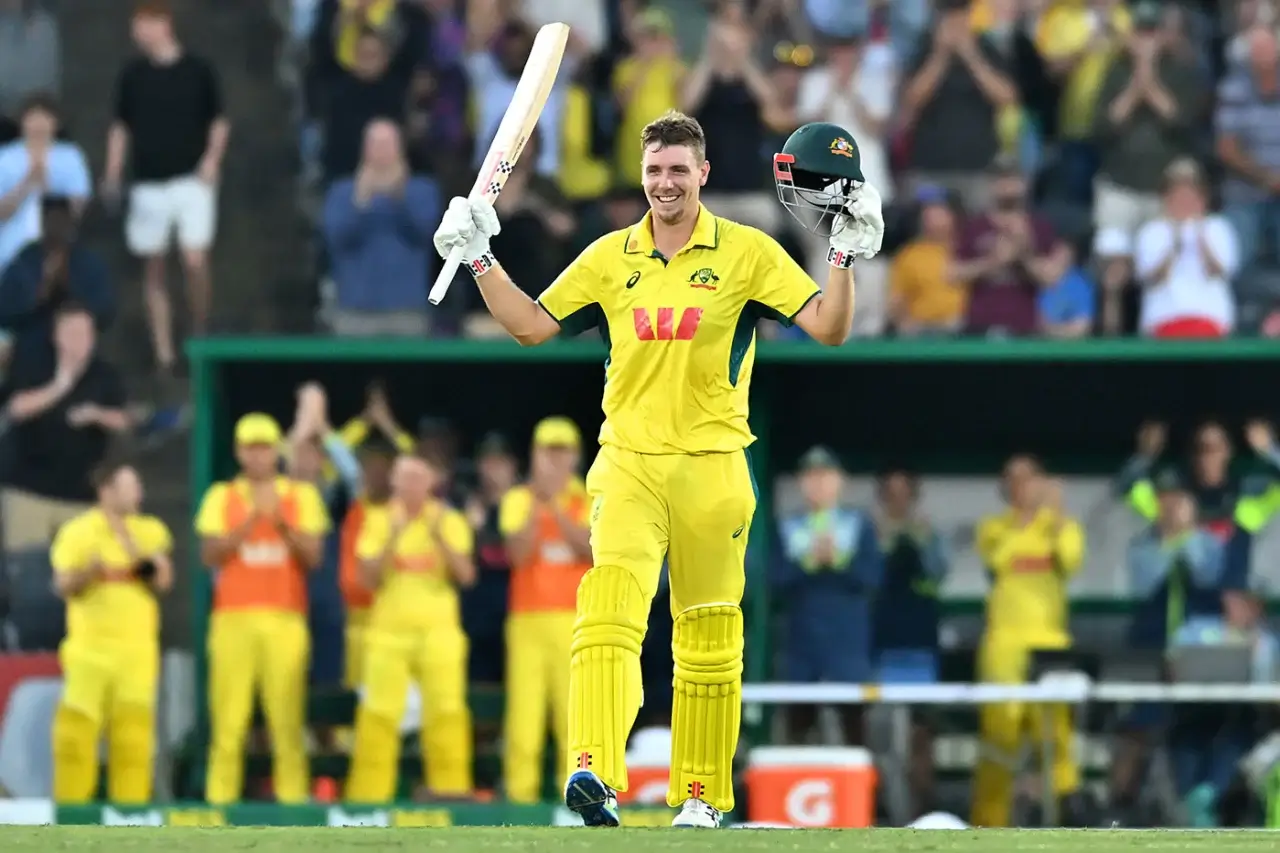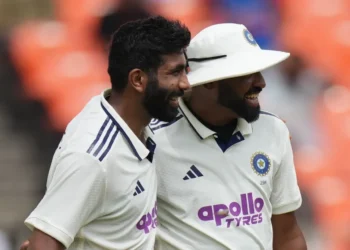Cricket fans love rare feats. In Mackay, Australia’s top three batters all scored centuries in an ODI. Travis Head made 142. Mitchell Marsh hit 100. Cameron Green added 118 not out. This helped Australia reach 431 for 2 against South Africa.
This was only the second time the top three did this in ODIs. The first was South Africa against West Indies in 2015. Hashim Amla scored 153 not out. Rilee Rossouw made 128. AB de Villiers blasted 149 off 44 balls.
Green’s ton came in 47 balls. That’s joint 11th fastest in ODIs. De Villiers holds the record at 31 balls. Matt Breetzke from South Africa scored his fourth half-century in four ODIs. He made 88 in Mackay. That’s a first for any player. He started with 150 against New Zealand. Then 83 vs Pakistan. And 57 vs Australia.
Navjot Singh Sidhu did it in four innings. But he didn’t bat in one match. Two Dutch players hit half-centuries in their first three ODIs. Tom Cooper and Max O’Dowd.
Sam Konstas debuted for Australia at 19. He was 11 years younger than the next player. That’s a record age gap. Sunil Gavaskar scored 10,122 Test runs. Only 16.51% in wins. But 11 players have lower percentages. Habibul Bashar has the lowest at 4.92%.
Kraigg Brathwaite has 29 Test wickets. All different batters. That’s the most without repeats. Australia shines in ICC events. They have 10 major men’s titles. Women’s team dominates too.
What makes them strong? Let’s check their ICC event wins and more. Like the India vs Bangladesh cricket timeline for rivalries.
Has Anyone Scored Half-Centuries in Their First Four ODIs Like Matt Breetzke?

Matt Breetzke made history last week. He scored 88 against Australia in Mackay. This was his fourth half-century in four ODIs. No one else has done this. He began with 150 vs New Zealand in Lahore. Then 83 against Pakistan. Next came 57 in Cairns vs Australia. Breetzke’s streak is unique.
Navjot Singh Sidhu came close. He scored 73, 55, 51, and 55 in 1987. But he skipped batting in one game. So it’s four innings, not matches. Only two others hit 50s in their first three ODIs. Tom Cooper for Netherlands. And Max O’Dowd too.
Breetzke’s feat shows quick adaptation. He faces tough bowlers early. His scores build confidence. Fans watch his next games closely. This record adds to ODI surprises. Like rare three centuries innings. It highlights new talents shining fast.
What Makes Breetzke’s Streak Stand Out?
Breetzke’s run is the first ever. Starting with a 150 is bold. He kept scoring against strong teams. This sets him apart from others.
Sidhu’s effort was in a World Cup. But the no-bat game breaks the match streak. Dutch players stopped at three. Breetzke pushes limits in half-centuries streak. His style fits modern ODIs. Quick runs matter. This could lead to more caps.
Is Australia’s Top Three Centuries in Mackay a Rare ODI Feat?
Australia’s batters dazzled in Mackay. Travis Head scored 142. Mitchell Marsh made 100. Cameron Green hit 118 not out. All top three got centuries. This is the second time in ODIs. First was South Africa in 2015. Hashim Amla 153 not out. Rilee Rossouw 128. AB de Villiers 149.
That’s five innings with three centuries total. But only two from top three. Green’s ton was fast at 47 balls. De Villiers’ 31-ball century is the quickest. Australia’s 431 for 2 was huge. It crushed South Africa.
This feat shows team depth. Top order sets big totals. It pressures opponents early. Fans love such power displays. Like in ODI top three centuries. It ties to Australia’s strength in big games.
Why Is This Combination So Special?
Top three centuries mean strong starts. It builds unbeatable scores. South Africa’s 439 for 2 was massive. De Villiers’ speed added thrill. Australia’s effort in 2025 echoes that. Green’s quick ton ranks high. Such games are rare gems in cricket. They inspire young players. Show how openers and No. 3 dominate.
Does Sunil Gavaskar Have the Lowest Percentage of Runs in Wins?
Sunil Gavaskar scored 10,122 Test runs. Only 1,671 in wins. That’s 16.51%. But it’s not the lowest. Eleven players have lower rates. All with 3,000+ runs. Habibul Bashar has 4.92%. Just 149 in wins out of 3,026. Hanif Mohammad at 7.28%. John Reid 8.66%. Four Indians are lower too. Vijay Manjrekar 8.42%. Polly Umrigar 12.56%.
Ravi Shastri 12.85%. Chandu Borde 16.47%. India’s wins were fewer then. Gavaskar’s era had tough matches. His total runs shine. But percentage reflects team results. This stat shows context matters. Wins depend on all players. Not just one batter.
Modern teams win more. So percentages rise. But old records like Bashar’s stay low. Weak teams hurt individual stats. Gavaskar’s 16.51% beats some legends. It highlights his skill in draws. Or losses. Fans value total runs more. But this adds depth to records.
What’s the Biggest Age Gap for Youngest in a Test Team Like Sam Konstas?
Sam Konstas debuted at 19 for Australia. Next youngest was 30. That’s 11 years gap. A record. Before, it was nine years. Aaqib Javed 16 vs Saleem Malik 25. In 1989. Biggest for oldest is 17 years. Miran Bakhsh 47 vs Abdul Kardar 30. In 1955.
First Test had 14 years gap. James Southerton 49 vs Tom Emmett 35. Konstas’ youth stands out. No twenties in team. Unusual for Australia. This shows experience mix. Young talent with vets. Helps in tough Tests.
At 19, Konstas brings fresh energy. Gap to Labuschagne is huge. Beats old record by two years. Pakistan’s young bowlers set marks. But Konstas’ batting debut differs. It inspires kids dreaming big.
Who Has Most Test Wickets Without Repeat Dismissals?
Kraigg Brathwaite has 29 Test wickets. All different batters. That’s the top mark. Mohammad Ashraful got 21 unique. Sajeewa de Silva 16. Travis Head 16 too.
Mark Butcher and Gareth Batty each 15. All unique. Brathwaite’s feat is rare. As an opener bowling part-time. Shows variety in victims. No repeats mean wide skills. Against many teams. This adds fun to stats. Part-timers surprise.
29 wickets without repeats is impressive. He bowls spin occasionally. Catches batters off guard. Others like Ashraful bowled more. But Brathwaite leads. It highlights West Indies’ all-round play. Fans enjoy such quirks. Adds depth to player profiles.
Why Does Australia Rule ICC Events So Often?
Australia leads with 10 major men’s ICC titles. Six ODI World Cups. One T20 World Cup. Two Champions Trophies. They won Test Championship once. Total ICC trophies reach 27 including others. Reasons include mental toughness. Raised on hard cricket. Strong preparation for big games. They respect players. Build team spirit. High win rates show this.
In finals, they dominate. Lost first ICC final in 15 years recently. Four straight wins before. This mindset sets them apart. Like in Australia ICC titles. Their system grooms winners. From youth to seniors.
Mental edge is key. Uncompromising play from young age. Prep focuses on pressure. Titles span formats. ODI dominance with six cups. T20 success too. This builds legacy. Inspires global teams.
How Are Double Hattrick and Three Top Centuries a Unique Mix in Cricket?
A double hattrick means four wickets in four balls. Rare feat in any format. Three top centuries are scarce. Only twice in ODIs for top three. Combination in one match? No known instances. Hat-trick and century exist separately.
In first-class, some did hat-trick and century. Like Roller with double century and hat-trick. But double hattrick with three centuries? Unheard. Would be ultimate rarity. In Mackay, three centuries happened. No hattricks. Shows how unique each is. This mix would thrill fans. Blend attack and defense peaks.
A double hat-trick needs a perfect bowling streak. Four dismissals straight. Three centuries require batting depth. Top order firing together. Together, it’s dream scenario. No records show it. Makes cricket exciting. Like unique cricket feats.
How Do Australia’s Men and Women Teams Crush World Cups?
Men’s team won six ODI World Cups. 1987, 1999, 2003, 2007, 2015, 2023. Most ever. One T20 World Cup in 2021. Strong in Tests too. Women’s team dominates more. Seven ODI World Cups. Six T20 World Cups.
Last three T20 titles straight. Unmatched in women’s sport. Both teams build on depth. Strong domestic play. Mental strength. Women won every trophy recently. Men appear in finals often.
This dual dominance sets standard. Like Australian men’s World Cup and women’s. System supports both. Talent from youth. Women lead with 13 total WCs. Men’s six ODIs top men. Combined, Australia rules. Inspires rivals. Like early cups, including first Women’s ODI World Cup.
How Does Australia’s Domestic Setup Boost Their Players?
Australia’s structure includes Sheffield Shield for first-class. One-Day Cup for limited-overs. Big Bash League for T20. Women’s National Cricket League too. Sheffield Shield builds Test skills. Tough matches hone batsmen and bowlers. Big Bash develops T20 flair. Attracts global stars. Improves under pressure in domestic team.
Competitive leagues like Shield test endurance. Big Bash adds excitement. Players move up smoothly. Performance in domestic leads to caps. This keeps Australia strong. In Sheffield Shield support and Big Bash League talent.
Talent pathways select from these. U19 to internationals. This feeds national teams. Strong domestic means ready players. Big Bash grew since 2011. Eight teams compete hard. Overall, it creates depth. Supports cricket domestic structure.
Conclusion
Cricket stats always surprise. Australia’s Mackay feat was the second ODI top three centuries. Green’s fast ton added spice. Breetzke’s four 50s in ODIs is a first. Sidhu close but not quite. Konstas’ 11-year gap sets debut record. Brathwaite’s 29 unique wickets tops list.
Gavaskar at 16.51% isn’t lowest. Bashar holds that at 4.92%. Australia’s ICC event wins come from toughness and prep. 10 men’s titles shine.
Double hattrick and three centuries combo remains unseen. Ultimate rare mix. Men and women dominate Cups. Men six ODIs. Women seven ODIs and six T20s.
Domestic like Shield and Big Bash builds stars. Pathways ensure success. These records make cricket fun. Inspire new fans. Keep watching for more feats.













